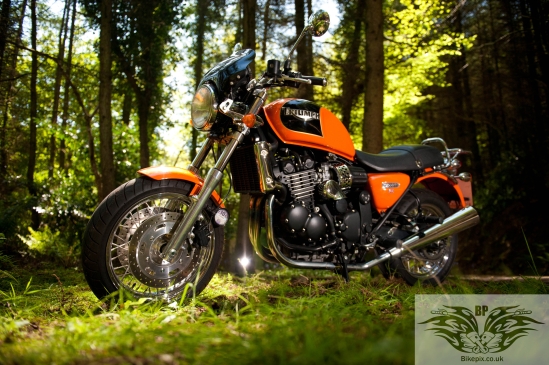Light Painting Project: Part 2 – Triumph Bonneville
The above photograph is the result of having used the ‘Light Painting’ technique to capture this image of a Triumph Bonneville SE. You may have read in the previous post how attempting to capture an image in one 30 second exposure caused the photographs to look drab and underexposed. Whilst I may have been able to tweak things in Photoshop, I’ve decided to show you those first shots so we can see the difference when multiple exposures are used.
Light Painting involves using a light source [1] to ‘paint’ in sections of the bikes detail using long exposures. These can typically be between 10 to 30 seconds or longer. However the difference in the image on this page compared to those in the previous post is that this wasn’t achieved by one exposure, but rather eight separate exposures where different sections of the bike were illuminated each time.
Once the multiple exposures are imported into Photoshop, it then becomes a matter of layering and blending them to achieve the desired effect.
Whilst the above bike photograph is pleasing, it can also be used as a starting point for something more elaborate, something more artistic.
Step 2: Here we see the project start to develop into something more like a poster.
To carry off this sort of picture art work convincingly, you need to pay attention to things like the colour tone and brightness of the added art work. For example the lightning has had a slight blue tone added to match the cool feel of the overall photograph.
This second version formed the basis the project and had all the elements in place, but it still wasn’t quite right?
The skull artwork is too prominent in the above photograph and also the lighting on the ‘face’ doesn’t match in with the overall scheme of things.
Step 3: Below is the final finished version with some subtle revisions having been made. The Skull has been resized, repositioned and toned down to make it less prominent. The aspect has also been changed to make it seem as if it is gazing at the bike.
Lastly, but also very importantly; the skull artwork was edited to take into account the lighting effect that was desired. By that I mean that right hand side (as we look at it) has been taken into shadow, which creates the effect that the light source is coming from the lightening. That attention to detail has also been carried out on the hood. Notice how the sides of the hood facing away from the light source are now in shadow.
These very subtle changes convey information that makes the picture more plausible and so have quite an impact on the finished product.
Notes:
[1] The light source can be almost anything, from a strobe flashgun on larger projects to smaller LED pen light torches. It was the latter that I used for this shoot.











